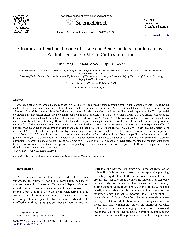摘要
Adsorption behavior of carbon dioxide confined in pillared clays is analyzed by using constant pressure Gibbs ensemble Monte Carlo (GEMC) method. In our simulation, I-site and 3-site models are used to represent carbon dioxide. At the I-site model, carbon dioxide is described as a Lennard-Jones (LJ) sphere, while at the 3-site model, carbon dioxide is modeled as a three-sites linear chain represented by EPM2 potential considering the quadrapolar effect. The potential model from Yi et at. for pillared clays is used to emphasize its quasi two-dimensional structure. Comparing the calculated results from the I-site and the 3-site models at T = 228.15 and 258.15 K, we observe that the adsorption amount from the two models is the same basically. However, the local density presents a significant difference, because the shoulder in the main peak near the wall from 3-site model can reflect the orientation of carbon dioxide. Accordingly, in the systematical investigation to explore the effect of porosity and pore width on the adsorption of carbon dioxide in pillared clays, the 3-site model was only used. We observe that for a narrow pore of H = 1.02 nm, each isotherm shape displays type I curve, suggesting that it is not inflected by the porosity. However, for the larger pores of H = 1.70 and H = 2.38 nm, the increase of the porosity alters the shape of adsorption isotherms from a simple linear relation to the first order jump, indicating that the porosity is of very important factor to affect adsorption and phase behavior of fluids confined in pillared clays. The excess adsorptions of carbon dioxide at supercritical temperatures of T = 323.15 and 348.15 K are also investigated. We find that the maximum exists for each excess isotherm, and the optimal pressure corresponding to the maximum increases with the pore width. However, the porosity has no significant effect on the optimal pressure.
- 出版日期2007-6-15
- 单位北京化工大学
